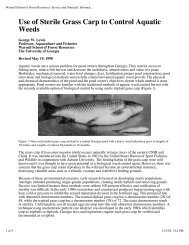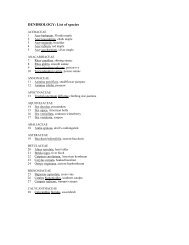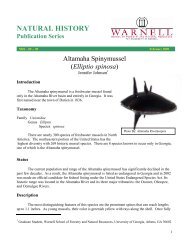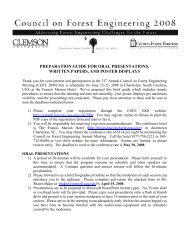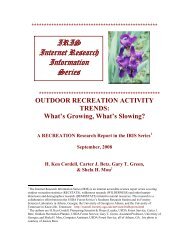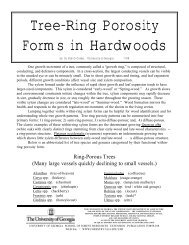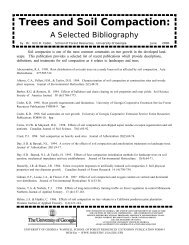Angler's Guide to Fish Diseases and Parasites - University of Georgia
Angler's Guide to Fish Diseases and Parasites - University of Georgia
Angler's Guide to Fish Diseases and Parasites - University of Georgia
Create successful ePaper yourself
Turn your PDF publications into a flip-book with our unique Google optimized e-Paper software.
Angler’s <strong>Guide</strong> <strong>to</strong> <strong>Fish</strong> <strong>Diseases</strong> <strong>and</strong> <strong>Parasites</strong>Prepared by George W. LewisAquaculture <strong>and</strong> <strong>Fish</strong>eries SpecialistOccasionally anglers catch fish that show signs <strong>of</strong> infection or parasitism. Is the fish safe <strong>to</strong> eat?The usual <strong>and</strong> safest response <strong>to</strong> this question is, “When in doubt - don’t.’’ However, very fewfish diseases can be transferred <strong>to</strong> humans. Almost all fish are safe <strong>to</strong> eat when thoroughlycooked, smoked or frozen.<strong>Fish</strong> are a valuable resource in <strong>Georgia</strong>. Not only do they provide important recreation, but theyare also a valuable supplement <strong>to</strong> the family food budget. The anticipation <strong>of</strong> any fisherman,whether he be a young boy with a cane pole <strong>and</strong> a can <strong>of</strong> worms or an ‘’old pro,” is a quality fishfor the table. It is the unwritten law <strong>of</strong> any true sportsman <strong>to</strong> utilize the fish he catches. Thepurpose <strong>of</strong> this publication is <strong>to</strong> help you, the angler, determine if the fish you’ve caught is worthy<strong>of</strong> your skillet. Remember, a sick fish will not take the hook.For convenience, we have listed groups <strong>of</strong> parasites diseases <strong>and</strong> other causes <strong>of</strong> abnormalitiessometimes seen in the fisherman’s catch.1. Viruses <strong>and</strong> Bacteria: These microorganisms cannot be seen with the naked eye. They causemany diseases in fish. Symp<strong>to</strong>ms include swollen, fluid-filled body cavity, bulging eyes, bloodyfins, bloody spots on the skin or base <strong>of</strong> scales, sores, <strong>and</strong> lesions, etc.2. Fungi: Fungi are small, str<strong>and</strong>-like parasites. They normally do not infect healthy fish. Theyusually grow on dead tissue or infected wounds. Most <strong>of</strong> the fungi on fish have a patchy,gray-white, cot<strong>to</strong>n-like appearance.
3. Pro<strong>to</strong>zoa: These are microscopic, single-cell animals. They can be found on the gills, bodysurface or imbedded in the flesh. There are many different pro<strong>to</strong>zoans, <strong>and</strong> they cause a variety <strong>of</strong>fish diseases. <strong>Fish</strong>erman usually observe the damage they cause but rarely see the microorganismwithout the aid <strong>of</strong> a microscope.4. Trema<strong>to</strong>de or Fluke: There are two groups <strong>of</strong> flukes. Monogenetic flukes live on the externalbody surface <strong>and</strong> multiply on the same host. Digenetic flukes are internal fish parasites <strong>and</strong>require two or more hosts <strong>to</strong> complete their life cycle. Other hosts may include snails, clams,birds or other fish - but not man. Trema<strong>to</strong>des can be found in cysts in the flesh or other internalorgans. They also can live in the eye, blood, gills <strong>and</strong> other parts <strong>of</strong> the fish. Trema<strong>to</strong>des arerarely observed by fisherman.5. Ces<strong>to</strong>de or Tapeworm: These parasites are commonly observed by fishermen when cleaningtheir catch. Larval tapeworms form cysts on or in the internal organs or in the body cavity. Adultsare white <strong>and</strong> worm-like <strong>and</strong> are found in the intestines.6. Acanthocephalan or Spiny-Headed Worm: These parasites are rarely seen by fishermen. Theylive in the intestines <strong>of</strong> fish.
7. Nema<strong>to</strong>de or Round Worm: Nema<strong>to</strong>des are very common parasites <strong>of</strong> ski. The larvae may befound in cysts or coiled in or on the internal organs. Adults are usually found in the intestines.Some are found coiled under the skin.8. Leeches: These parasites are external, blood-feeding animals. They leave circular wounds onthe fish.9. Copepods: These small crustaceans can be embedded in flesh, gills or mouth. Some movefreely over the body surface.10. Tumors: As on other animals, tumors occasionally occur on fish.11. Physical Injury: Preda<strong>to</strong>rs, such as birds <strong>and</strong> other fish, can cause wounds <strong>and</strong> othermalformities.
OBSERVED EXTERNALLYVisual SignsLesions, sores, hemorrhages, fish pop-eyed,blood under scales, or loss <strong>of</strong> scales.CommentsVarious species <strong>of</strong> bacteria can infect fish.Symp<strong>to</strong>ms vary depending on bacteria <strong>and</strong>fish species. Bacterial infections are usuallythe result <strong>of</strong> a stress on the fish or infection<strong>of</strong> a wound. An infected fish is edible. Trimaway infected flesh.Cot<strong>to</strong>n-like, white-tan-gray fuzzy growth onbody or fins.Fungus infection <strong>of</strong> wound or lesion. Aninfected fish is edible. Trim away infectedflesh.Small, pinhead-size white spots on the skin<strong>of</strong> catfish <strong>and</strong> sometimes excessive mucus(slime) production.Ich (Ichthyophthirius) is a common pro<strong>to</strong>zoanparasite <strong>of</strong> catfish. It occurs on theskin <strong>and</strong> gills <strong>of</strong> catfish <strong>and</strong> some other fishspecies. An infected fish is edible. Clean<strong>and</strong> prepare as usual.Small, black-<strong>to</strong>-purple spots under the skinor in the flesh <strong>of</strong> scale fish.Black Spot is one <strong>of</strong> the more frequentparasites observed by fishermen. It is causedby larval flukes encysting under the skin orin the flesh. An infected fish is edible. Clean<strong>and</strong> prepare as usual.Eye opaque or deformed.Eye Flukes live in the fluid <strong>of</strong> the eye.Although they cannot be seen by the fishermen,they eventually cause blindness in thefish. An infected fish is edible. Clean <strong>and</strong>prepare as usual.
Gills swollen <strong>and</strong> pinkThere are a number <strong>of</strong> gill parasites infectingfish. They are microscopic <strong>and</strong> only thedamage they cause is observed by the fisherman.Some <strong>of</strong> these parasites are gill flukes<strong>and</strong> a number <strong>of</strong> Pro<strong>to</strong>zoan species. Chemicalsin the water can also irritate the gills <strong>and</strong>present the same symp<strong>to</strong>ms. Unless chemicalsare suspected, the fish is edible. Clean<strong>and</strong> prepare as usual.Thread-like red worm extending from theanus.Roundworms can be found throughout theintestines. They sometimes can be seenextending from the anus. An infected fish isedible. Clean <strong>and</strong> prepare as usual.Worm-like animal attached <strong>to</strong> the body,head, fins, or gills.Leeches are blood-sucking animals that leavea circular wound after they have dropped <strong>of</strong>fthe fish. An infected fish is edible. Clean <strong>and</strong>prepare as usual.Small, red pustual with red thread-like bodyprotruding from wound at the base <strong>of</strong> scaleor on or near the base <strong>of</strong> fins.Anchor Worm is an appropriate name for thisparasitic copepod. It buries its anchorshapedhead in<strong>to</strong> the flesh <strong>and</strong> allows itsbody <strong>to</strong> hang free <strong>of</strong> the wound. An infectedfish is edible. Clean <strong>and</strong> prepare as usual.Small, bloody areas at the base or under thescales <strong>of</strong> a fish.<strong>Fish</strong> Louse are microscopic copepods rarelyseen by fishermen. They feed on the bloodby piercing. the skin. The bites can becomeinfected. An infected fish is edible. Clean<strong>and</strong> prepare as usual.
OBSERVED INTERNALLYWhite worms in the intestine.Adult flukes, tapeworms, roundworms orspiny-headed worms are commonly observedin the intestines <strong>of</strong> fish. The fish is edible.Clean <strong>and</strong> prepare as usual.Large, white flat worm in body cavity.Tapeworm found in the body cavity <strong>of</strong> carpsuckers, minnows <strong>and</strong> some other fish. Thefish is edible. Clean <strong>and</strong> prepare as usual.Worm encysted on internal organs coiled likea watch spring.Larval Roundworm. The fish is edible.Clean <strong>and</strong> prepare as usual.Small cysts on internal organs.Larval Flukes. The fish is edible. Clean <strong>and</strong>prepare as usual.Small, white thread-like worms on or ininternal organs.Larval Tapeworms. Often found in theovaries. The fish is edible. Clean <strong>and</strong>prepare as usual.Small, white-<strong>to</strong>-orange worm in body cavityor attached <strong>to</strong> intestines.Spiny-headed worm usually lives insideintestines. Sometimes they are found lying inthe body cavity with their heads buried in theintestines. The fish is edible. Clean <strong>and</strong>prepare as usual.



